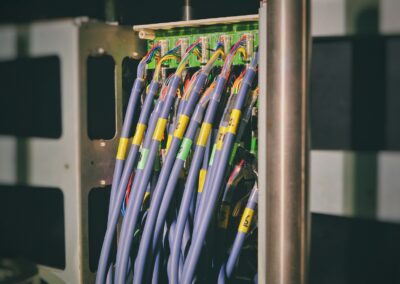The Role of Encryption in Safeguarding IoT Devices
Understanding the Threat of Man-in-the-Middle Attacks
One of the most significant threats to IoT device is the man-in-the-middle (MitM) attack, where an attacker intercepts and potentially alters the communication between two devices. This type of attack can lead to unauthorized access to sensitive data, control over device functions, and severe security breaches. Understanding how to protect IoT devices from such threats is crucial for ensuring their safe and effective use.
In a MitM attack, the attacker secretly relays and possibly alters the communication between two parties who believe they are directly communicating with each other. This can be particularly dangerous for IoT devices that handle sensitive information or control critical systems. For example, an attacker could intercept the communication between a smart thermostat and the heating system, potentially causing harm or inconvenience to the user. The implications of such attacks are even more significant in industrial IoT applications, where they can disrupt operations and compromise safety.
The Importance of Encryption in IoT Security
Encryption is one of the most effective methods for protecting IoT devices from MitM attacks. By encrypting the data transmitted between devices, it becomes significantly more challenging for an attacker to intercept and decipher the information. Encryption ensures that even if the data is intercepted, it remains unreadable without the correct decryption key. This layer of security is essential for maintaining the confidentiality and integrity of the data exchanged between IoT devices.
Implementing strong encryption protocols can provide robust protection against unauthorized access and data breaches. For business executives and entrepreneurs in regions like Saudi Arabia, UAE, Riyadh, and Dubai, where IoT technology adoption is accelerating, investing in encryption technologies is critical. It not only safeguards their assets but also enhances customer trust and compliance with data protection regulations. As IoT devices become more prevalent in various sectors, from healthcare to smart cities, ensuring their security through encryption is a vital step in mitigating risks.
Adopting Effective Encryption Protocols
Several encryption protocols can be adopted to enhance the security of IoT devices. One widely used protocol is the Advanced Encryption Standard (AES), which provides robust security for data at rest and in transit. AES is known for its efficiency and strength, making it a preferred choice for securing IoT communications. Another important protocol is Transport Layer Security (TLS), which ensures secure communication over networks. TLS is commonly used in web browsing, email, and instant messaging, and it can also be applied to IoT devices to protect data transmissions.
Additionally, IoT devices can benefit from protocols like Datagram Transport Layer Security (DTLS), which is designed for securing datagram-based applications. DTLS is particularly useful for IoT applications that require low-latency and high-performance communication, such as real-time monitoring and control systems. By adopting these encryption protocols, businesses can create a secure environment for their IoT devices, protecting them from potential MitM attacks and other cyber threats.
Implementing Best Practices for IoT Encryption
End-to-End Encryption for Comprehensive Security
To ensure the highest level of security for IoT devices, it is essential to implement end-to-end encryption. This approach involves encrypting the data at the source and only decrypting it at the intended destination. End-to-end encryption prevents attackers from accessing the data at any point during its transmission, providing comprehensive protection against MitM attacks. This method is particularly important for IoT devices that handle sensitive information, such as healthcare devices and financial systems.
For business leaders in Saudi Arabia, UAE, Riyadh, and Dubai, implementing end-to-end encryption can significantly enhance their cybersecurity posture. By securing the entire communication pathway, organizations can prevent data breaches and maintain the confidentiality and integrity of their data. This approach also aligns with global data protection regulations, ensuring compliance and minimizing legal risks.
Regular Security Audits and Updates
Maintaining the security of IoT devices requires ongoing vigilance and proactive measures. Regular security audits and updates are essential for identifying and addressing vulnerabilities in encryption protocols and other security mechanisms. By conducting periodic assessments, businesses can ensure that their encryption methods remain effective against evolving cyber threats. These audits should include testing the strength of encryption keys, verifying the implementation of security protocols, and identifying potential weaknesses in the IoT infrastructure.
In addition to security audits, timely updates to encryption software and firmware are crucial. Cyber threats are constantly evolving, and outdated encryption methods can become susceptible to new attack vectors. By keeping encryption protocols and related software up to date, businesses can protect their IoT devices from emerging threats and maintain a robust security posture.
Training and Awareness for IoT Security
Another critical aspect of enhancing IoT security is educating employees and stakeholders about the importance of encryption and best practices for protecting IoT devices. Training programs should cover topics such as recognizing potential security threats, implementing secure communication protocols, and maintaining encryption keys. By raising awareness and promoting a culture of security, organizations can reduce the risk of human error and enhance their overall cybersecurity defenses.
For regions like Saudi Arabia and UAE, where technological advancements and IoT adoption are rapidly growing, investing in cybersecurity training is essential. Business executives and mid-level managers must understand the significance of encryption in protecting their IoT assets and take proactive steps to ensure the security of their devices. By fostering a security-conscious workforce, organizations can create a resilient environment that can withstand cyber threats and safeguard their valuable data.
Conclusion
In the era of IoT, ensuring the security of connected devices is paramount. The threat of man-in-the-middle attacks highlights the need for robust encryption protocols to protect data transmission and maintain the integrity of IoT systems. By adopting effective encryption methods such as AES, TLS, and DTLS, and implementing best practices like end-to-end encryption, regular security audits, and comprehensive training programs, businesses can significantly enhance the security of their IoT devices.
For business leaders in Saudi Arabia, UAE, Riyadh, and Dubai, prioritizing IoT device encryption is not only a matter of cybersecurity but also a strategic imperative for business success. As the adoption of IoT technology continues to grow, securing these devices against cyber threats will be crucial for maintaining consumer trust, complying with regulations, and driving innovation. By learning from past incidents and adopting proactive security measures, organizations can protect their IoT investments and ensure a secure and prosperous future.
—
#IoTDeviceEncryption #ManInTheMiddleAttacks #Cybersecurity #IoTSecurity #BusinessSuccess #LeadershipSkills #ProjectManagement #ArtificialIntelligence #SaudiArabia #UAE #Riyadh #Dubai































